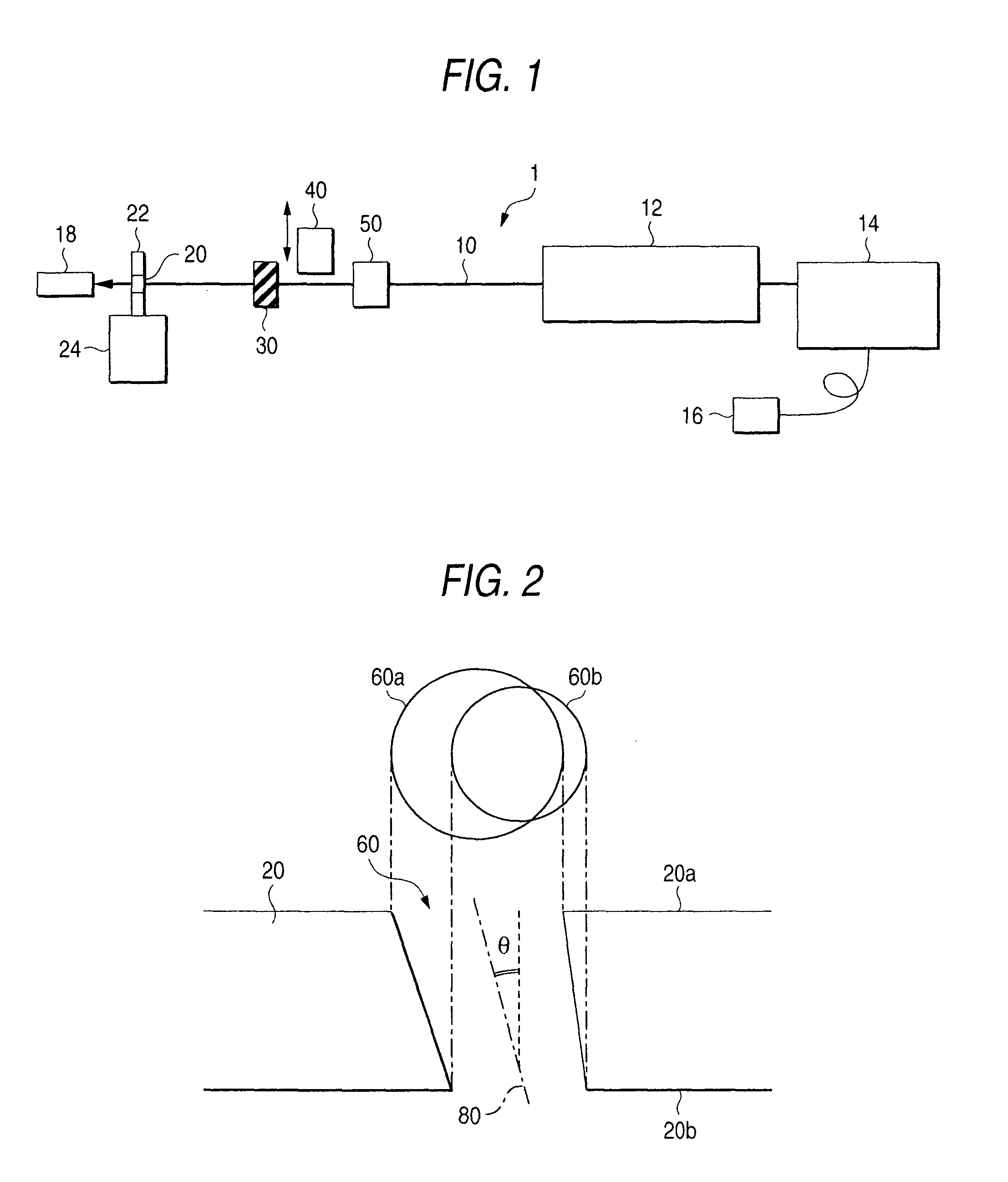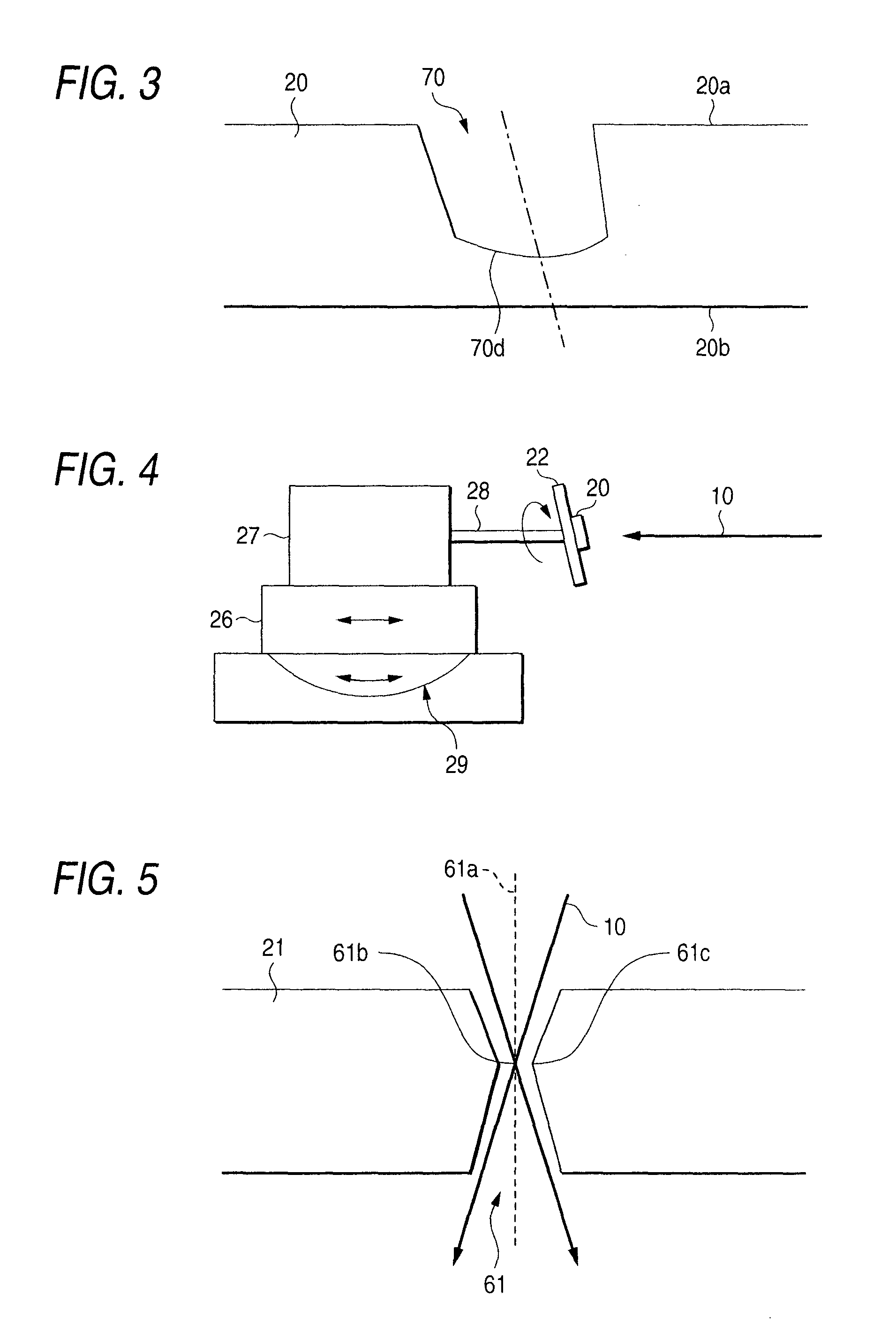Glass structure and method for producing the same
a technology of glass structure and glass, applied in the direction of glass tempering apparatus, manufacturing tools, instruments, etc., can solve the problems of large etching apparatus, wet etching, and difficulty in reducing the machining threshold, so as to reduce the machining threshold, improve the shape controllability, and improve the effect of processability
- Summary
- Abstract
- Description
- Claims
- Application Information
AI Technical Summary
Benefits of technology
Problems solved by technology
Method used
Image
Examples
embodiment 1
(Embodiment 1)
[0047]The substrate holder 22 was inclined by a predetermined angle θ from a direction perpendicular to the optical axis of the laser beam 10 to thereby produce an oblique hole inclined at the angle to the thickness direction of the glass substrate 20. The angle of the oblique hole can be adjusted by adjustment of the inclination angle θ of the specimen.
[0048]FIG. 2 typically shows sectional and plan views of a through-hole 60 formed in a 0.3 mm-thick glass substrate 20 fixed to be inclined at an angle θ=15° to the optical axis of the laser beam 10 when irradiation energy per unit area of the laser beam is constant (8 J / cm2). (For convenience' sake, the hole diameter shown in FIG. 2 is magnified to be larger than the actual value compared with the thickness of the substrate.)
[0049]Incidentally, the beam diameter of the laser beam 10 on a front surface of the substrate was set at about 100 μm. The shapes 60a and 60b of the hole 60 at front and rear surfaces 20a and 20b ...
embodiment 2
(Embodiment 2)
[0053]The third and fourth harmonics of an Nd:YAG laser was used as a laser beam. Machining was performed while the irradiation power of the laser beam was changed by the attenuator 50. During the machining, the stage 24 was fixed and the distance between the laser light source 12 and the glass substrate 20 was kept constant. The initial value of irradiation energy per unit area was set at 15 J / cm2. The irradiation energy was reduced with the passage of time, that is, the irradiation energy was changed continuously so that it became 5 J / cm2 when the hole pierced the glass substrate 20. As the irradiation power decreased, the beam diameter of the laser beam decreased.
[0054]Under the condition, there was obtained a through-hole having a taper angle of about 10° which was large compared with the case where the irradiation power was constant. If the laser beam irradiation was stopped before the machined portion pierced the substrate, it was possible to form a cavity having...
embodiment 3
(Embodiment 3)
[0057]The third and fourth harmonics of an Nd:YAG laser were used as the laser beam. During machining, the stage 24 was moved in parallel to the direction of the optical axis of the laser beam 10 to change the distance L between the laser light source 12 and the glass substrate 20. While the diameter of the laser beam applied on the glass substrate 20 was changed in this manner, a through-hole or a cavity was produced. The irradiation power of the laser beam was kept constant during the machining.
[0058]Because a specimen is placed in front of a beam waist which is formed when the laser beam is converged by a lens, irradiation energy per unit area increases and the area irradiated with the laser beam decreases as the distance L between the light source and the surface irradiated with the laser beam increases.
[0059]The distance L between the laser light source 12 and the glass substrate 20 at the time of start of machining was set at 95 mm. The distance L was adjusted so...
PUM
| Property | Measurement | Unit |
|---|---|---|
| wavelength | aaaaa | aaaaa |
| wavelength | aaaaa | aaaaa |
| wavelength | aaaaa | aaaaa |
Abstract
Description
Claims
Application Information
 Login to View More
Login to View More - R&D
- Intellectual Property
- Life Sciences
- Materials
- Tech Scout
- Unparalleled Data Quality
- Higher Quality Content
- 60% Fewer Hallucinations
Browse by: Latest US Patents, China's latest patents, Technical Efficacy Thesaurus, Application Domain, Technology Topic, Popular Technical Reports.
© 2025 PatSnap. All rights reserved.Legal|Privacy policy|Modern Slavery Act Transparency Statement|Sitemap|About US| Contact US: help@patsnap.com



